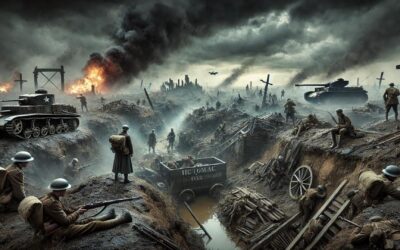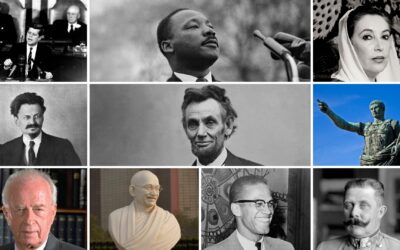The Nuclear Arms Race and Doomsday Scenarios: A Tale of Two Superpowers
In the shadows of the 20th century, a story unfolded; a race not for gold or glory, but for supremacy and survival. The protagonists? The USA and the USSR. Their weapon of choice? Nuclear warheads, capable of obliterating humanity several times over. This was the nuclear arms race.
The Buildup: USA and USSR’s Game of Shadows
As the curtains fell on World War II, two superpowers emerged from the ashes, both armed with nuclear might and distinct ideologies. The United States, having used atomic bombs on Hiroshima and Nagasaki, showed the world the destructive potential of this new weapon. The Soviet Union, not to be outdone, tested its own bomb in 1949.
The next decades were marked by frantic nuclear proliferation. The USA developed the hydrogen bomb, a weapon even more powerful than the atomic bomb, in 1952. The USSR quickly followed suit a year later. The race was on. By the 1980s, both countries collectively possessed over 60,000 nuclear warheads. This immense arsenal was more than enough to obliterate life as we know it.
The Doctrine of Mutual Assured Destruction (MAD)
While the sheer number of these weapons was terrifying, it was the strategy behind them that was truly chilling: Mutual Assured Destruction, or MAD. It was simple and brutal: if one side launched a nuclear attack, the other would retaliate with full force, ensuring both nations’ destruction. This concept, however grim, was rooted in the hope that the threat of total annihilation would deter either side from pressing the red button.
Close Calls: The Brush with the Abyss
However, the course of this race was not always steady, and humanity came close to its doomsday more than once.
One such incident was the 1983 Soviet nuclear false alarm. Stanislav Petrov, a Soviet lieutenant colonel, was on duty one fateful night when the early-warning system detected an incoming missile from the US. Moments later, the system reported five more. Protocol dictated an immediate and full-scale retaliatory strike. But Petrov, with a gut feeling that the alarm was false, disobeyed orders and chose not to launch. His intuition was right; it was a system malfunction. Petrov’s decision, in the face of immense pressure, possibly saved the world from nuclear catastrophe.
Living Under the Shadow: The Weight of the Bomb
The nuclear arms race was not just a geopolitical contest; it also left an indelible mark on the psyche of the global populace. Families built fallout shelters in their backyards, schools ran ‘duck and cover’ drills, and children grew up with the knowledge that a war could wipe out their world in a matter of minutes.
Culture reflected this collective anxiety. Movies, books, and songs of the era were rife with apocalyptic imagery and narratives. The haunting question was everywhere: What happens if the bombs fall?
In the West, tales like “On the Beach” and “Dr. Strangelove” explored the grim aftermath of nuclear warfare. In the Soviet bloc, works such as “Letters from a Dead Man” showcased the bleak landscapes of a post-nuclear world.
This constant looming threat also had a profound psychological impact. The fear of annihilation, combined with the ever-present Cold War tensions, created an environment of perpetual anxiety. Many lived with the belief that nuclear war wasn’t a matter of ‘if’, but ‘when’.
Conclusion: From Brinkmanship to Hope
The end of the Cold War and subsequent arms reduction treaties have reduced the immediate threat of a nuclear apocalypse. However, the lessons from this era remain relevant. They serve as a stark reminder of the responsibilities that come with possessing weapons of mass destruction and the fine line between deterrence and disaster.
The tale of the nuclear arms race is not just a historical recounting; it is a cautionary story of humanity’s capacity for self-destruction and its ability to find hope in the darkest of times. The shadow of the bomb may have receded, but its imprint on our collective consciousness endures, urging us to tread cautiously in our quest for power and dominance.
Keywords:
- Superpowers: Countries that have dominant influence or strength on the international stage.
- Proliferation: Rapid increase or spread of something, especially weapons.
- Mutual Assured Destruction (MAD): A military strategy where both sides possess the ability to destroy each other completely, ensuring that neither side initiates a conflict.
- Retaliate: To take action in response to harm or provocation.
- Geopolitical: Relating to politics, especially international relations, influenced by geographical factors.
- Fallout Shelters: Protective structures designed to keep people safe from radioactive fallout after a nuclear explosion.
- Apocalyptic: Relating to or predicting the complete destruction of the world.
- Annihilation: Complete destruction or obliteration.
- Brinkmanship: The art or practice of pursuing a dangerous policy to the limits of safety.
- Deterrence: The act of discouraging or preventing an action through the fear of consequences.
Key Takeaways:
- The nuclear arms race was a competition between the USA and USSR for nuclear supremacy in the 20th century.
- Both countries developed massive arsenals, capable of completely destroying each other.
- The doctrine of Mutual Assured Destruction (MAD) posited that the threat of mutual destruction would deter either country from launching an attack.
- The world experienced near-miss nuclear confrontations, such as the 1983 Soviet nuclear false alarm.
- The cultural and psychological impacts of the arms race were profound, with society constantly living under the threat of nuclear war.
Check out the Story of the Cold War Article Series
Cold War Chronicles: From Superpower Showdowns to Silent Echoes (Featured Article)
The Nuclear Arms Race: An Era of Fear and Hope
CIA vs. KGB: The Hidden Wars of the Cold War Era
The Cold War’s Echo in Africa: Decolonization and Proxy Battles
The Non-Aligned Movement: Navigating the Cold War’s Tumultuous Seas
Echoes of the Cold War: Its Indelible Mark on Popular Culture & Media
Capitalism vs. Communism: The Economic Tug of War during the Cold War










0 Comments